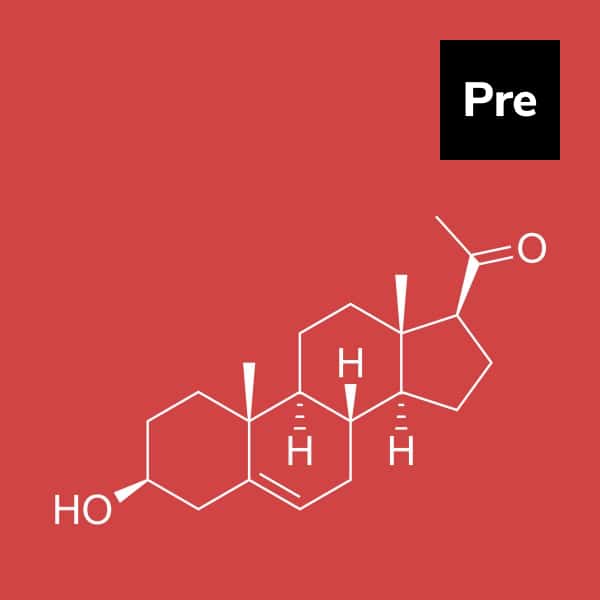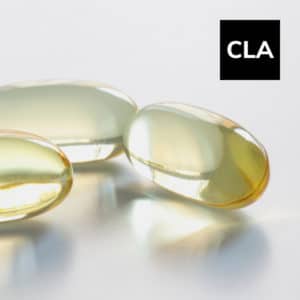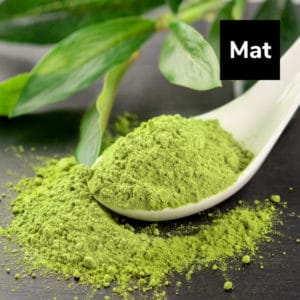Overview
Pregnenolone is naturally produced from cholesterol in the adrenal glands, gonads, and brain. It is a precursor of DHEA, progesterone, estrogen, testosterone, cortisol, and other hormones. Optimal levels are needed for mental health and cognition. Diet, stress, exercise, hypothyroidism, and your age affect how much pregnenolone your body produces. By age 70, most people only have 60% of optimal levels.
Key Benefits
- Supports mental acuity
- Protects against age-related memory impairment
- Supports uplifted mood
- Helps lower cholesterol levels
- Helps relieve stress
- May provide anti-aging effects
- Supports restful sleep
History of Usage
Adolf Butenandt and colleagues synthesized pregnenolone for the first time in 1934. It was originally used in medicine in the 1940s as an anti-inflammatory treatment. Pregnenolone is a neurosteroid and anti-inflammatory drug that was used to treat rheumatoid arthritis and soft-tissue rheumatism in the 1950s but is no longer accessible commercially. Rather than that, it is now sold as a dietary supplement. It can be taken orally, used topically, or injected into the muscle.
Biochemistry
The primary steroid produced from cholesterol is pregnenolone (PREG). PREG is synthesized in three major locations: the gonads, adrenal glands, and brain, and is subjected to a variety of metabolizing pathways that are controlled by a variety of variables. When considering steroids in their whole, PREG is frequently referred to as the precursor to other steroids because it is metabolized in the body to estrogen.
Pregnenolone and its derivatives stimulate neuronal activity by improving learning and memory, alleviating depression, stimulating locomotor activity, and boosting neuronal cell survival. They accomplish this by activating a variety of target proteins found in the cytoplasm or on the cell membrane. Pregnenolone and its metabolites bind to receptors such as microtubule-associated proteins and neurotransmitter receptors, eliciting a variety of reactions such as microtubule stabilization, increased intracellular ion flow, and dopamine release. The broad spectrum of neurosteroids’ activities suggests that pregnenolone derivatives may have a bright future in the treatment of neurological illnesses.
Pregnenolone supplementation is molecularly identical to the pregnenolone produced naturally by the body. Pregnenolone is synthesized from wild yams (Dioscorea villosa), which are grown in Mexico and other tropical locations worldwide. After extracting diosgenin from the yams, the component is synthesized to form pregnenolone.
Consuming meals high in healthy fats such as avocados, coconut oil, olive oil, walnuts, salmon, chia seeds, and flax seeds promotes pregnenolone synthesis.
Recent Trends
Because pregnenolone is supposed to reduce the aging process (though this has not been established) and because cognitive impairment diseases such as Alzheimer’s are on the rise, sales are expected to continue to grow among seniors.
Precautions
- Women who are pregnant or breastfeeding should abstain from taking pregnenolone.
- Before beginning to use pregnenolone, consult your health care provider.
- Individuals who are estrogen-sensitive, such as those who have breast cancer, uterine cancer, ovarian cancer, endometriosis, or uterine fibroids, should avoid using pregnenolone.
- Take no estrogen, progesterone, or testosterone if you are already taking any of these hormones.
- Pregnenolone may cause skin rashes, acne, hair loss, diarrhea or constipation, difficulty sleeping, excitement, sweating, or tremor in certain individuals. Additionally, it can result in an irregular heartbeat, depressed mood, hunger changes, muscle soreness, or irritation.
References
- Darnaudery M, Pallares M, Piazza PV, Le Moal M, Mayo W. The neurosteroid pregnenolone sulfate infused into the medial septum nucleus increases hippocampal acetylcholine and spatial memory in rats. Brain Res. 2002 Oct 4;951(2):237-42.
- 5. Mayo W, Lemaire V, Malaterre J, et al. Pregnenolone sulfate enhances neurogenesis and PSA-NCAM in young and aged hippocampus. Neurobiol Aging. 2005 Jan;26(1):103-14.
- 6. Jaliffa CO, Howard S, Hoijman E, et al. Effect of neurosteroids on the retinal gabaergic system and electroretinographic activity in the golden hamster. J Neurochem. 2005 Jul 11.
- Dzugan SA, Arnold SR. Hypercholesterolemia treatment: a new hypothesis or just an accident? Med Hypotheses. 2002 Dec;59(6):751-6
- Vallée M. Neurosteroids and potential therapeutics: Focus on pregnenolone. J Steroid Biochem Mol Biol. 2016 Jun;160:78-87. doi: 10.1016/j.jsbmb.2015.09.030. Epub 2015 Oct 1. PMID: 26433186.
- McGavack TH, Chevalley J, Weissberg J. The use of delta 5-pregnenolone in various clinical disorders. J Clin Endocrinol Metab. 1951 Jun;11(6):559-77.
- Weng JH, Chung BC. Nongenomic actions of neurosteroid pregnenolone and its metabolites. Steroids. 2016 Jul;111:54-59. doi: 10.1016/j.steroids.2016.01.017. Epub 2016 Feb 1. PMID: 26844377.
- Osuji IJ, Vera-Bolaños E, Carmody TJ, Brown ES. Pregnenolone for cognition and mood in dual diagnosis patients. Psychiatry Res. 2010 Jul 30;178(2):309-12. doi: 10.1016/j.psychres.2009.09.006. Epub 2010 May 21. PMID: 20493557.
- Araghiniknam M, Chung S, Nelson-White T, Eskelson C, Watson RR. Antioxidant activity of dioscorea and dehydroepiandrosterone (DHEA) in older humans. Life Sci. 1996;59(11):L147-57.
- George MS, Guidotti A, Rubinow D, Pan B, Mikalauskas K, Post RM. CSF neuroactive steroids in affective disorders: pregnenolone, progesterone, and DBI. Biol Psychiatry. 1994 May 15;35(10):775-80.




